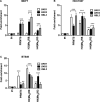Protein arginine methyltransferase 5 (PRMT5) activates WNT/β-catenin signalling in breast cancer cells via epigenetic silencing of DKK1 and DKK3
- PMID: 33462997
- PMCID: PMC7875925
- DOI: 10.1111/jcmm.16260
Protein arginine methyltransferase 5 (PRMT5) activates WNT/β-catenin signalling in breast cancer cells via epigenetic silencing of DKK1 and DKK3
Abstract
Protein arginine methyltransferase 5 (PRMT5) activity is dysregulated in many aggressive cancers and its enhanced levels are associated with increased tumour growth and survival. However, the role of PRMT5 in breast cancer remains underexplored. In this study, we show that PRMT5 is overexpressed in breast cancer cell lines, and that it promotes WNT/β-CATENIN proliferative signalling through epigenetic silencing of pathway antagonists, DKK1 and DKK3, leading to enhanced expression of c-MYC, CYCLIN D1 and SURVIVIN. Through chromatin immunoprecipitation (ChIP) studies, we found that PRMT5 binds to the promoter region of WNT antagonists, DKK1 and DKK3, and induces symmetric methylation of H3R8 and H4R3 histones. Our findings also show that PRMT5 inhibition using a specific small molecule inhibitor, compound 5 (CMP5), reduces PRMT5 recruitment as well as methylation of H3R8 and H4R3 histones in the promoter regions of DKK1 and DKK3, which consequently results in reduced expression CYCLIN D1 and SURVIVIN. Furthermore, CMP5 treatment either alone or in combination with 5-Azacytidine and Trichostatin A restored expression of DKK1 and DKK3 in TNBCs. PRMT5 inhibition also altered the growth characteristics of breast cancer cells and induced their death. Collectively, these results show that PRMT5 controls breast cancer cell growth through epigenetic silencing of WNT/β-CATENIN pathway antagonists, DKK1 and DKK3, resulting in up-regulation of WNT/β-CATENIN proliferative signalling.
Keywords: PRMT5; WNT/β-CATENIN proliferative signalling; breast cancer; epigenetic silencing; tumour suppressors.
© 2021 The Authors. Journal of Cellular and Molecular Medicine published by Foundation for Cellular and Molecular Medicine and John Wiley & Sons Ltd.
Conflict of interest statement
The authors declare that they have no conflict of interest with the contents of this article.
Figures







Similar articles
-
Protein arginine methyltransferase 5 (PRMT5) promotes survival of lymphoma cells via activation of WNT/β-catenin and AKT/GSK3β proliferative signaling.J Biol Chem. 2019 May 10;294(19):7692-7710. doi: 10.1074/jbc.RA119.007640. Epub 2019 Mar 18. J Biol Chem. 2019. PMID: 30885941 Free PMC article.
-
Epigenetic silencing of the WNT antagonist Dickkopf 3 disrupts normal Wnt/β-catenin signalling and apoptosis regulation in breast cancer cells.J Cell Mol Med. 2013 Oct;17(10):1236-46. doi: 10.1111/jcmm.12099. Epub 2013 Jul 24. J Cell Mol Med. 2013. PMID: 23890219 Free PMC article.
-
Inhibition of PRMT5-mediated regulation of DKK1 sensitizes colorectal cancer cells to chemotherapy.Cell Signal. 2024 Jul;119:111166. doi: 10.1016/j.cellsig.2024.111166. Epub 2024 Apr 6. Cell Signal. 2024. PMID: 38588876
-
Aberrant miRNA expression and protein arginine methyltransferase 5 (PRMT5) in cancer: A review.Biochim Biophys Acta Mol Cell Res. 2025 Mar;1872(3):119923. doi: 10.1016/j.bbamcr.2025.119923. Epub 2025 Feb 22. Biochim Biophys Acta Mol Cell Res. 2025. PMID: 39993609 Review.
-
The PRMT5 arginine methyltransferase: many roles in development, cancer and beyond.Cell Mol Life Sci. 2015 Jun;72(11):2041-59. doi: 10.1007/s00018-015-1847-9. Epub 2015 Feb 7. Cell Mol Life Sci. 2015. PMID: 25662273 Free PMC article. Review.
Cited by
-
Role of PRMT1 and PRMT5 in Breast Cancer.Int J Mol Sci. 2024 Aug 14;25(16):8854. doi: 10.3390/ijms25168854. Int J Mol Sci. 2024. PMID: 39201539 Free PMC article. Review.
-
The Structure and Functions of PRMT5 in Human Diseases.Life (Basel). 2021 Oct 12;11(10):1074. doi: 10.3390/life11101074. Life (Basel). 2021. PMID: 34685445 Free PMC article. Review.
-
A review of the known MTA-cooperative PRMT5 inhibitors.RSC Adv. 2024 Dec 17;14(53):39653-39691. doi: 10.1039/d4ra05497k. eCollection 2024 Dec 10. RSC Adv. 2024. PMID: 39691229 Free PMC article. Review.
-
Cabergoline possesses a beneficial effect on blood-brain barrier (BBB) integrity against lipopolysaccharide (LPS).Bioengineered. 2021 Dec;12(1):8358-8369. doi: 10.1080/21655979.2021.1987066. Bioengineered. 2021. PMID: 34592907 Free PMC article.
-
Novel Chemicals Derived from Tadalafil Exhibit PRMT5 Inhibition and Promising Activities against Breast Cancer.Int J Mol Sci. 2022 Apr 27;23(9):4806. doi: 10.3390/ijms23094806. Int J Mol Sci. 2022. PMID: 35563196 Free PMC article.
References
-
- World Cancer Report 2014 . World Cancer Report. International Agency for Research on Cancer; 2014.
Publication types
MeSH terms
Substances
Grants and funding
LinkOut - more resources
Full Text Sources
Other Literature Sources
Research Materials

